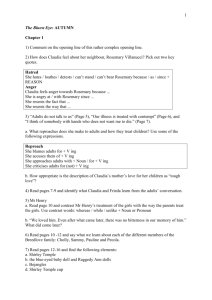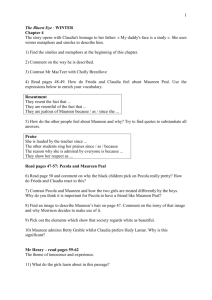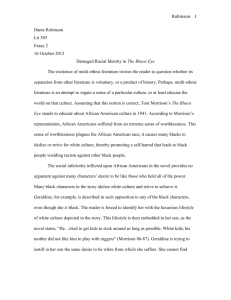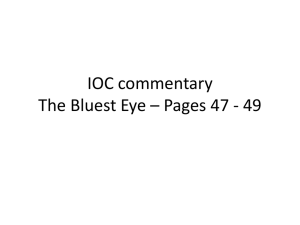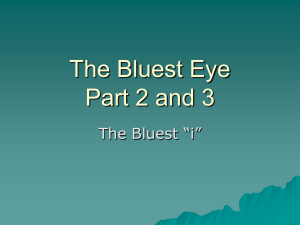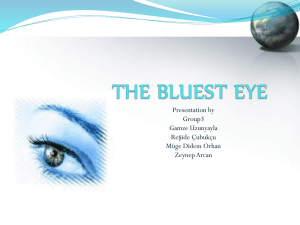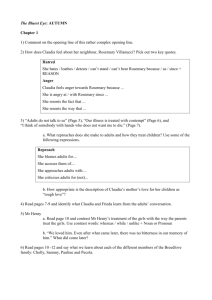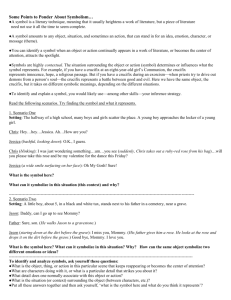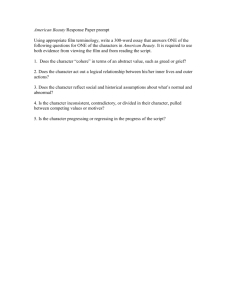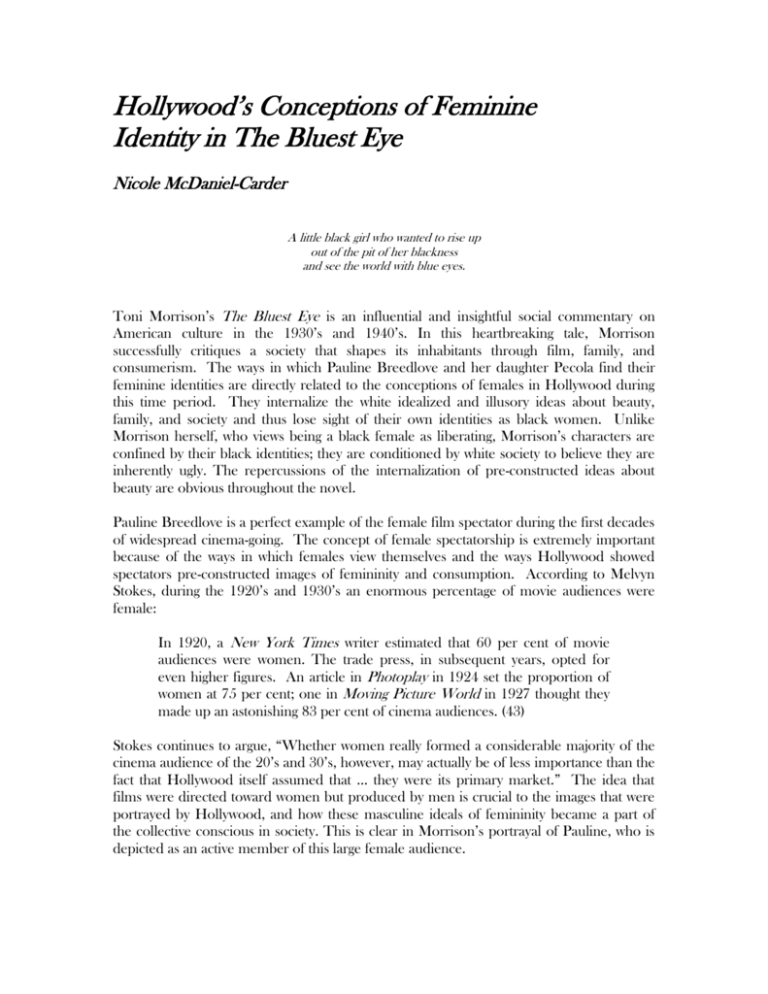
Hollywood’s Conceptions of Feminine
Identity in The Bluest Eye
Nicole McDaniel-Carder
A little black girl who wanted to rise up
out of the pit of her blackness
and see the world with blue eyes.
Toni Morrison’s The Bluest Eye is an influential and insightful social commentary on
American culture in the 1930’s and 1940’s. In this heartbreaking tale, Morrison
successfully critiques a society that shapes its inhabitants through film, family, and
consumerism. The ways in which Pauline Breedlove and her daughter Pecola find their
feminine identities are directly related to the conceptions of females in Hollywood during
this time period. They internalize the white idealized and illusory ideas about beauty,
family, and society and thus lose sight of their own identities as black women. Unlike
Morrison herself, who views being a black female as liberating, Morrison’s characters are
confined by their black identities; they are conditioned by white society to believe they are
inherently ugly. The repercussions of the internalization of pre-constructed ideas about
beauty are obvious throughout the novel.
Pauline Breedlove is a perfect example of the female film spectator during the first decades
of widespread cinema-going. The concept of female spectatorship is extremely important
because of the ways in which females view themselves and the ways Hollywood showed
spectators pre-constructed images of femininity and consumption. According to Melvyn
Stokes, during the 1920’s and 1930’s an enormous percentage of movie audiences were
female:
In 1920, a New York Times writer estimated that 60 per cent of movie
audiences were women. The trade press, in subsequent years, opted for
even higher figures. An article in Photoplay in 1924 set the proportion of
women at 75 per cent; one in Moving Picture World in 1927 thought they
made up an astonishing 83 per cent of cinema audiences. (43)
Stokes continues to argue, “Whether women really formed a considerable majority of the
cinema audience of the 20’s and 30’s, however, may actually be of less importance than the
fact that Hollywood itself assumed that … they were its primary market.” The idea that
films were directed toward women but produced by men is crucial to the images that were
portrayed by Hollywood, and how these masculine ideals of femininity became a part of
the collective conscious in society. This is clear in Morrison’s portrayal of Pauline, who is
depicted as an active member of this large female audience.
The effect of film on Pauline seems extreme yet is portrayed honestly. Like other women
at the time, Pauline was displaced in society. To escape from her work, her life, and her
husband, “she went to the movies instead” (Morrison 122). In Pauline’s chapter, the
reader is shown how the onscreen images became internalized.
The onliest time I be happy seem like was when I was in the picture show.
Every time I got, I went. I’d go early, before the show started. They’d cut
off the lights, and everything be black. Then the screen would light up, and
I’d move right on in them pictures. White men taking such good care of
they women, and they all dressed up in big clean houses with the bathtubs
right in the same room with the toilet. Them pictures gave me a lot of
pleasure, but it made coming home hard, and looking at Cholly hard. (123)
Pauline’s increasing dissatisfaction with her life signifies her growing internalization of
Hollywood’s conceptions of beauty, family, and society. These conceptions were not
Pauline’s reality, but that of the idealized white, upper-middle-class society. (Morrison’s
commentary about these ideals is also evident in her use of the Dick & Jane reader, and the
ways in which these ideals become distorted.) Stokes points out, “While many women in
the Blumer survey identified with female stars to the extent of wanting to copy their
appearance, hair-styles, clothes, jewels and personal mannerisms, such identification was
often a complicated process” (52). Here, he is commenting on the difficulties women
would face if they were to go into public wearing a copied fashion from the silver screen.
Yet the Blumer survey does not necessarily take into consideration the difficulties that a
black female, particularly of the working class, would face were she to try to behave in the
same way as the starlets. For white women, these figures were often a manifestation of
women’s rights and served to enhance the viewer’s self-esteem. The same was not true for
black female viewers because of the unchangeable difference of skin color. Pauline does
attempt to imitate a screen star, and she comes to the opposite result—her innate “ugliness”
seems confirmed instead of negated:
I ’member one time I went to see Clark Gable and Jean Harlow. I fixed my
hair up like I’d seen hers on a magazine. A part on the side, with one little
curl on my forehead. It looked just like her. Well, almost just like. … I was
sitting back in my seat, and I taken a big bite of that candy, and it pulled a
tooth right out of my mouth. I could of cried. I had good teeth, not a
rotten one in my head. I don’t believe I ever did get over that. There I
was, five months pregnant, trying to look like Jean Harlow, and a front tooth
gone. Everything went then. Look like I just didn’t care no more after that.
I let my hair go back, plaited it up, and settled down to just being ugly. I still
went to the pictures, though, but the meanness got worse. (123)
(Presumably, the film was Red Dust, a Gable/Harlow film from 1932.) This is a painful
moment; the juxtaposition of Pauline’s image as a gap-toothed, pregnant black woman with
the illusory and idealized image of Jean Harlow on screen makes both images powerful and
shows the destructive effect that imitating Harlow has on Pauline’s sense of beauty. Pauline
does not react to the screen goddesses in the same way that many white female viewers did
at the time, because she knows that she will only get to be “almost just like,” and never “just
like,” the screen stars. But she has already internalized these silver screen images, and even
names her daughter, Pecola, after a figure in the screen adaptation of Imitation of Life,
Peola (played by black actress Fredi Washington).
The reference to Imitation of Life in The Bluest Eye highlights the film’s inherent
importance to the novel. Maureen Peal, a light-skinned classmate of Pecola’s, brings this to
our attention, and proceeds to give a basic plot summary of the film:
“Pecola? Wasn’t that the name of the girl in Imitation of Life?”
“I don’t know. What is that?”
“The picture show, you know. Where this mulatto girl hates her mother
cause she is black and ugly but then cries at the funeral. It was real sad.
Everybody cries in it. Claudette Colbert too.”
“Oh.” Pecola’s voice was no more than a sigh.
“Anyway, her name was Pecola too. She was so pretty. When it comes
back, I’m going to see it again. My mother has seen it four times.” (67)
This reference to Imitation of Life is crucial in examining the cultural reactions to the
assertions the film makes about mother-daughter relationships and racial conflicts within
the family. Not only has Pauline internalized these Hollywood ideals, but the other females
in society have as well. For example, the reference to Maureen’s mother seeing the film
four times is indicative of the appeal it has for her. There is something in the film with
which she identifies.
Maureen is presented as a “high-yellow dream child” with “a hint of spring in her sloe
green eyes, something summery in her complexion, and a rich autumn ripeness in her
walk” (62). Claudia and Frieda, Maureen’s schoolmates, despise her because she is lighterskinned and middle-class, and because she is not tormented by the boys as they and Pecola
are. Maureen’s lighter complexion gives her more self-confidence, and thereby power,
because she seems to have society on her side. Like the boys earlier in the chapter,
Maureen uses the other girls’ darker color as an insult, even though she is only slightly
lighter:
“Black? Who you calling black?
“You!”
“You think you so cute!” [Claudia] swung at her and missed, hitting Pecola
in the face. …
Safe on the other side, she screamed at us, “I am cute! And you ugly!
Black and ugly e mos. I am cute!” (73)
Morrison herself comments on the fact that Maureen was not given the consideration as a
character that she deserved. She is one-dimensional and an easy target for Claudia and
Frieda’s displaced anger because they, too, have been bombarded with screen images of
beauty. Their reaction to it is violence, which echoes the beginning of the story where
Claudia tells the reader about her hatred of white dolls (and thus the white concept of
beauty).
At the beginning of the novel, when Pecola is staying at their house, Claudia and Frieda
discuss Shirley Temple with her. Claudia reacts violently, saying, “I hated Shirley. Not
because she was cute, but because she danced with Bojangles, who was my friend, my
uncle, my daddy, and who ought to have been soft-shoeing it and chuckling with me” (19).
Further on, she states, “much later I learned to worship [Shirley]” (23). These
developments are very important to the growth of Claudia’s conceptions about beauty;
obviously she has not been made to feel ashamed about the way she looks as Pecola has.
The fact that Claudia is jealous of Shirley Temple for dancing with Bojangles indicates
Claudia’s unwillingness to accept that, because she is black, she is therefore unworthy of
attention. Yet the fact that she says there was a point where she “learned to worship
[Shirley]” shakes the reader; the figure who seems to be the strongest in her identity and
the closest to her roots is also tainted by Hollywood’s ideals of beauty. Another reference
to screen stars is made through Mr. Henry, who, upon introduction to the girls, says,
“Hello there. You must be Greta Garbo, and you must be Ginger Rogers” (16). Although
this is in no way detrimental to the girls’ search for identities, it does perpetuate the cultural
ideal of white film stars being the most admired figures for children.
Imitation of Life also deals with the idea of being stuck between two cultures. Peola
Johnson, a light-skinned black girl, tries to pass herself off as white. In doing so, she
ostracizes her family, disowns her mother, and ultimately tries to fit in with the white
community, where she does not belong. As paramount as the problems are for the young
black girls of The Bluest Eye, who are constantly shown images of females considered
beautiful yet who look nothing like them, the problems for the Maureen Peal figure, as well
as for Peola Johnson in the film, are also serious. Sandy Flitterman-Lewis comments:
In each film’s representation of the transgressive woman—the black
daughter who looks white, and who, because of the contradiction between
being and seeming which defines her, can fit comfortably into neither
culture—there is a correspondence between feminine sexuality and alterity
which results in a sexualization of the radical ‘otherness’ of the black
woman. (44)
This idea is crucial to the way in which Pecola’s character is formed, and finally to how her
demise comes about, although her identification with the mulatto figure is, in fact, purely
interior. Pecola can also be understood as marginalized in society because she is thought
to live between worlds. Her circumstances are thus very similar to the complicated
situation of the mulatto figure.
Pauline has consumed the onscreen images to such a degree that she is willing to name her
daughter after a mulatto character, although neither she nor her daughter is mulatto. The
difficulties that the light-skinned daughter, Peola, goes through in Imitation of Life are
serious and their repercussions are far-reaching: Peola disowns her dark-skinned mother,
thereby refusing her mother’s culture, and passes for white. In the film, Peola cries, “It’s
because of you, you made me black! I won’t be black!” Traditionally, a mother would not
wish this fate for herself or her daughter, yet it seems here that both Maureen Peal’s
mother and Pauline do: Maureen’s mother has seen Imitation of Life four times,
emphasizing the connection she feels to the film, while Pauline names her daughter after
Peola and embraces white ideals of beauty. This maternal identification is perhaps the
reason that Maureen feels she can approach Pecola in the first place; she may be trying to
reach out to someone who could understand her predicament. As Maureen runs away
saying, “I’m cute!” to Pecola, Claudia, and Frieda, she is reinforcing the idea that to be
black is to be inherently ugly. It is through the societal conception of beauty that Maureen
feels she has some self-worth and a place where she can fit in. In Imitation of Life, this is
taken to another level because the mere term mulatto “immediately suggests
miscegenation, which itself evokes both forbidden sexual relations and the impossible
mixing of races” (Flitterman-Lewis 46). Maureen is considered pretty, well-dressed, and
has a conversation about menstruation (a subject about which she is more knowledgeable
than the narrators are). This implied sexuality is crucial to the way in which her character is
viewed in the novel, but it seems to be glossed over. Instead, she turns it over to Pecola,
commenting about how Pecola has seen her father naked.
With this remark, Maureen’s work as a figure in the novel is complete. She has raised the
question of Pecola’s overt sexuality, foreshadowing that there will be some problem
concerning Pecola and her father. The reader understands that she will eventually be
raped by him. Ultimately, Pecola is unable to find a cultural identity because of her youth
and naïveté; the only way she finds an identity at all is through her madness.
The gravity of “passing” is not dealt with in great detail in either the film or the novel. It
stands to reason that the audience’s knowledge of this kind of situation could be assumed;
yet that seems risky. Passing is an extremely serious offense, one that no community looks
kindly on. There are various references to this topic throughout literary history; perhaps
the most notable is Alex Haley’s Queen. Passing is also dealt with repeatedly in film,
particularly during the 30’s, and again during the civil rights movement with films like Show
Boat. Although Pecola is not able to pass for white because she is of a darker hue, her
desire for blue eyes is an indication of her wish to be accepted by the white community and
ultimately by her family, who has internalized to an excessive degree the standards of
beauty promoted by the white community. The only way she feels that she can do either of
these things is by obtaining blue eyes, thereby being “seen” as less black.
The roles for black women at this time were obviously not the same as the roles for white
women; very rarely were black women seen as leading ladies. They were “mammies,” such
as in Gone With the Wind, or they were sexual deviants, like Julie’s figure in Show Boat,
who passed for white to marry a white man, only to be discovered and fired from her job.
Peola’s character in Imitation of Life deals with these same kinds of stereotyped roles; by
passing she is able to get a job, but it is seen as a more sexualized role. This is particularly
evident in the 1959 version, as she works in various nightclubs, but it is also evident in the
earlier version. These roles for black females in film reinforce the position of the black
female in life: either they accept the standards of beauty promoted by the white community
(and essentially try to pass or become sexual deviants), or they must become “mammy”
figures, servants in the homes of more affluent whites.
Pauline chooses the latter: she works as a servant in the home of the white Fishers. The
comparison between Pecola and the Fishers’ daughter emphasizes the internalization of
white beauty that guides Pauline’s feelings. The Fisher girl asks “Polly” who the girls in the
kitchen, Pecola, Claudia and Frieda, were, and instead of telling her, Pauline hushes her
and tells her not to worry about it. Pauline’s shame over her own daughter in comparison
to the Fisher girl is paramount in this scene. Pauline is not concerned with tending to her
own child, but instead, as Claudia watches the scene, Pauline “spit[s] words out to us like
rotten pieces of apple,” and then turns her attention back to her charge, “hushing and
soothing the tears of the little pink-and-yellow girl” (109). The Fisher girl, blonde and
dressed in pink, can be seen as a type of doll, like the one Claudia dismembers at the
beginning of the novel. There is a harsh distinction between Pauline playing with the
Fishers’ daughter’s hair, and the disgust she feels toward the hair of her own daughter.
Pecola understands this, having also internalized the community’s ideas about beauty.
These ideas are manifested in her desire for blue eyes.
The wish for blue eyes has interesting connotations. Eye color has no effect on vision;
therefore, Pecola does not desire blue eyes so that she may see the world differently.
Rather, eye color has everything to do with being seen, and because Pecola has no one who
truly does see her, she does not value her own self-worth or feel that she possesses an
identity. The idea of “seeing” is directly related to film. Typically, the “gaze” is masculine;
in a film, it is usually through a “masculine lens” that the narrative is told. Therefore, the
pleasure that women take in “narrative cinema is based on different processes of
spectatorship” (Stacey 367). Both of the men who “gaze” upon Pecola do so in less than
complimentary ways. First, Cholly does so to the extent that he sees in her something that
he also saw in her mother, which eventually leads him to rape her. Second, Soaphead
Church, a charlatan who promises Pecola that he can give her the blue eyes she desires,
would be considered something of a pedophile. These characters reinforce the concept of
the masculine gaze projecting sexual images onto its target. Neither man sees Pecola for
who she truly is, much in the same way that audiences do not see film stars for their true
identities.
Stacey continues, “women are argued to oscillate between masculine and feminine
identifications” (369). Pauline does this well. She wants to be beautiful in the same ways
that female film stars are beautiful, and she desires the same for her daughter. Here, she
can be said to be looking through feminine eyes, trying to imitate the screen stars and
pretending that somehow she is like them. Yet she also looks through masculine eyes when
she refuses to empathize with Pecola after the rape, viewing her as some kind of sexual
creature to be frowned upon. These ideas are vital to The Bluest Eye because it is not the
masculine gaze that Pecola desires, nor is it the masculine gaze under which she suffers
initially. Ultimately, it is a combination of male and female gazes: a societal gaze.
The fact that she looks nothing like Pauline’s image of beauty gives Pecola reason to
believe she is ugly. Pecola then does everything she can to not be seen:
And Pecola. She hid behind hers. Concealed, veiled, eclipsed—peeping
out from behind the shroud very seldom, and then only to yearn for the
return of her mask. (39)
The comparison here between Pecola’s desire for blue eyes, not with which to see, but so
that others will see her, and the way in which Pecola wields her “ugliness,” is compelling.
She is ashamed of her color and position in society, and she hides her identity behind her
belief in her own ugliness.
Pauline, Pecola, and the other women in The Bluest Eye are caught between being who
they truly are and being who society wants them to be. Morrison shows her readers the
difficulties of black females during this time period, bombarded with images of the “ideal”
woman who looks nothing like them, and without any true figures to emulate. This kind of
propaganda was obviously detrimental to their perceived inner beauty and self-worth.
Morrison wrote this book in the civil rights era, a time when the idea of “Black is Beautiful”
as a mantra began to emerge, and women of color began to feel that embracing their
blackness was the most important way of positively establishing their identity. Morrison
made it clear that this was not an option for the characters in The Bluest Eye, thus
exposing the society of the time and its long-reaching effects.
WORKS CITED
Flitterman-Lewis, Sandy, “Imitation(s) of Life: The Black Woman’s Double
Determination as Troubling ‘Other’,” Literature and Psychology 34.4 (1988), 4257.
Morrison, Toni, The Bluest Eye. New York: Plume, 1994.
Stacey, Jackie, “Desperately Seeking Difference,” in The Sexual Subject: A Screen Reader
in Sexuality, ed. John Caughie and Annette Kuhn (London: Routledge, 1992), 244257.
Stokes, Melvyn, “Female Audiences of the 1920s and Early 30s,” in Identifying
Hollywood’s Audiences: Cultural Identity at the Movies, ed. Melvyn Stokes and
Richard Maltby (London: BFI, 1999), 42-60.

